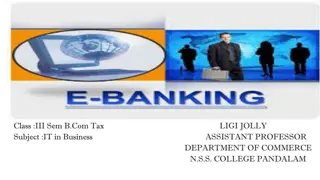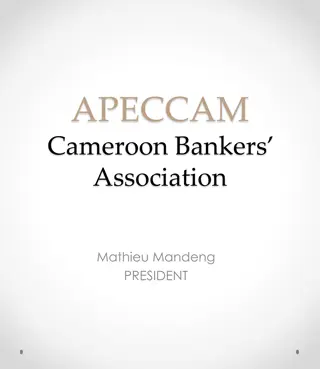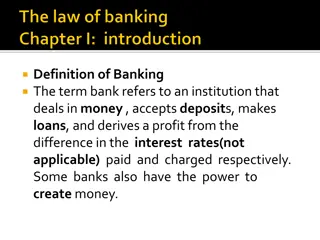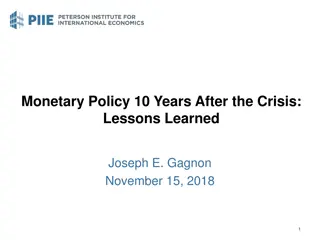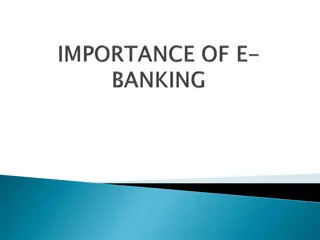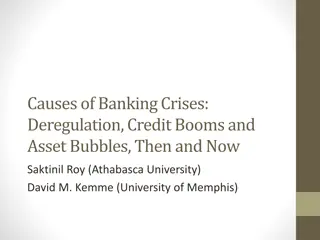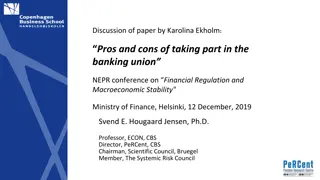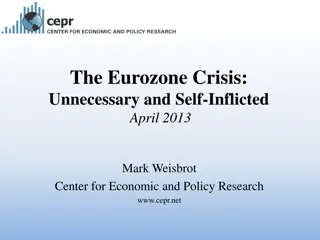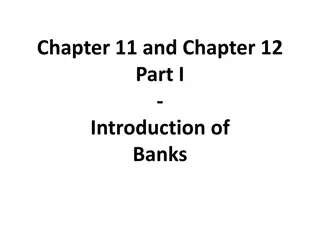Panel Discussion on Banking Crisis in 2023: Lessons Learned and Future Strategies
Expert panelists discuss the implications of the banking crisis in 2023, including regulatory developments, the effectiveness of policies, and debates on resolving financial institutions. The discussion covers the US and European experiences, focusing on large and small banks, as well as potential strategies moving forward.
Download Presentation

Please find below an Image/Link to download the presentation.
The content on the website is provided AS IS for your information and personal use only. It may not be sold, licensed, or shared on other websites without obtaining consent from the author.If you encounter any issues during the download, it is possible that the publisher has removed the file from their server.
You are allowed to download the files provided on this website for personal or commercial use, subject to the condition that they are used lawfully. All files are the property of their respective owners.
The content on the website is provided AS IS for your information and personal use only. It may not be sold, licensed, or shared on other websites without obtaining consent from the author.
E N D
Presentation Transcript
Banking Crisis in 2023: Not-So-Big Too Big To Fail banks? Panelists Donald Bernstein, Davis Polk Lisa Schweitzer, Cleary Gottlieb Prof. Ignacio Tirado, SG Unidroit and Universidad Auton ma Madrid Moderated by prof. Rolef de Weijs, UvA & Houthoff June 12, 2023, 13:00 14:15 0
Outline I) Development from 2008 onwards: Resolution & Capital (25 min) Dodd Frank & Single Point of Entry, TLAC/MREL and liquidity requirements (15 min) BRRD and EU rules (10 min) II) What worked and what did not? (25 min) US Experience (15 min) US: SVB (10 min) US: First Republic and Signature (3 min) Was focus on large banks too narrow? How different are small banks from big banks? (2 min) European Experience (10 min) Banco Popular (Spain), BBRD applied Swiss experience, in Europe but outside EU III) Policy debate and way forward (25 min) 1
Hypothetical Single Point of Entry Resolution of U.S. Bank Holding Company under the U.S. Federal Bankruptcy Code
Single Point of Entry Resolution Under Bankruptcy Code HYPOTHETICAL FINANCIAL INSTITUTION STRUCTURE FOR DISCUSSION Financial Institution Public Shareholders Bank Holding Company Domestic Broker-Dealer Foreign Broker-Dealer Bank Note: This is a hypothetical and greatly simplified U.S. financial institution structure. The location of various legal entities, including whether they are in a separate legal chain or in a chain with a domestic insured bank, varies from firm to firm. Asset management entities are not shown. Foreign Bank Branch Foreign Subsidiary 3
Single Point of Entry Resolution Under Bankruptcy Code HYPOTHETICAL FINANCIAL INSTITUTION STRUCTURE BEFORE FINANCIAL DISTRESS (cont.) Top-Tier BHC Stand-alone Balance Sheet ($bn)* Assets Liabilities These BHC assets can be used to recapitalize and provide liquidity to OpCos after the onset of financial distress Cash and Other HQLAs 25 Unsecured long-term debt (external TLAC debt) 100 External TLAC BHC Deposits in Bank Advances to Domestic Broker-Dealer Advances to Foreign Broker-Dealer 35 15 10 Equity of Bank Equity of Domestic Broker-Dealer Equity of Foreign Broker-Dealer 75 15 10 Unsecured short-term debt 0 Other Assets 15 Equity 100 Total 200 Total 200 * The figures used in this SPOE hypothetical are meant to be illustrative only. Note: This is a BHC stand-alone balance sheet, which shows only BHC investments in OpCos, and not the OpCos assets and liabilities. A consolidated balance sheet would show that the firm has $850bn $1tn in assets. 4
Single Point of Entry Resolution Under Bankruptcy Code HYPOTHETICAL LOSSES Public Shareholders Losses in Subs ($bn) Total Losses: $50 bn Remaining BHC Equity: $50 bn Bank: $40 Loss $35 Remaining Equity Bank Holding Company Domestic Broker-Dealer: $5 Loss $10 Remaining Equity Foreign Broker-Dealer: $5 Loss $5 Remaining Equity Domestic Broker-Dealer Foreign Broker-Dealer Bank Foreign Bank Branch Foreign Subsidiary 5
Single Point of Entry Resolution Under Bankruptcy Code HYPOTHETICAL LOSSES (cont.) Top-Tier BHC Stand-alone Balance Sheet After Losses and Before Recapitalization ($bn) Assets Liabilities Cash and Other HQLAs 25 Unsecured long-term debt 100 BHC Deposits in Bank Advances to Domestic Broker-Dealer Advances to Foreign Broker-Dealer 35 15 10 Equity of Bank Equity of Domestic Broker-Dealer Equity of Foreign Broker-Dealer 75 35 15 10 10 5 Unsecured short-term debt 0 Other Assets 15 Equity 100 50 Total 200 150 Total 200 150 6
Single Point of Entry Resolution Under Bankruptcy Code OPCOS RECAPITALIZED AND PROVIDED LIQUIDITY PRIOR TO BHC BANKRUPTCY Top-Tier BHC Stand-alone Balance Sheet After Recapitalization Actions ($bn) Assets Liabilities Contributions of capital and liquidity to OpCos must be structured to be resilient against avoidance and other legal challenges in BHC bankruptcy proceedings. Cash and Other HQLAs 25 2 Unsecured long-term debt 100 BHC Deposits in Bank Advances to Broker-Dealer 1 Advances to Broker-Dealer 2 35 0 15 0 10 0 Equity of Bank Equity of Broker-Dealer 1 Equity of Broker-Dealer 2 35 93 10 25 5 15 Unsecured short-term debt 0 Other Assets 15 Equity 50 Total 150 Total 150 After providing capital and liquidity to its OpCos pursuant to secured Support Agreement, the BHC commences chapter 11 proceedings and immediately files transfer motion 7
Single Point of Entry Resolution Under Bankruptcy Code TRANSFER OF OPCOS TO DEBT-FREE NEW HOLDCO OWNED BY TRUST FOR BENEFIT OF BANKRUPTCY ESTATE OF BHC Recapitalized OpCos are transferred to New HoldCo owned by Resolution Trust for benefit of BHC s bankruptcy estate pursuant to Section 363 Transfer Order Trust Left-behind debts of BHC subject to plan of reorganization BHC Beneficiary in chapter 11 proceedings (debtor in possession) Guarantee Obligations of OpCos QFCs assumed by New HoldCo New HoldCo Transfer Pursuant to Sale Order Claims left behind Long-term debt: 100 Recapitalized Domestic Broker-Dealer Recapitalized Foreign Broker-Dealer Recapitalized Bank Foreign Bank Branch Foreign Subsidiary 8
Single Point of Entry Resolution Under Bankruptcy Code NEW HOLDCO STAND-ALONE BALANCE SHEET New HoldCo Stand-alone Balance Sheet ($bn) Assets Liabilities Only some of the BHC s liquid resources are transferred to New HoldCo; the remainder is left behind in the BHC to cover chapter 11 administrative expenses (not shown here). This is New HoldCo s balance sheet. As adjusted, $1 billion is transferred to New HoldCo, and $1 billion is left behind in the BHC s bankruptcy estate. Cash and Other HQLAs 1 Unsecured long-term debt 0 Equity of Bank Equity of Broker-Dealer 1 Equity of Broker-Dealer 2 Unsecured short-term debt 0 93 25 15 Other Assets 15 Equity 149 Total 149 Total 149 Capital Levels of recapitalized OpCos and New HoldCo exceed pre-loss levels to facilitate stabilization* * The New Holdco will be required to comply with capital requirements generally applicable to fully capitalized and open bank holding companies. 9
Readiness for Resolution Using Single Point of Entry Recapitalization Resolution Readiness Mandated for G-SIBs by US Regulators Ex ante TLAC and liquidity requirements Structural feature bank holding company with sufficient bail-in resources that can be put into bankruptcy Sufficient Bail-in Resources to Recapitalize the Group External TLAC and Internal TLAC Liquidity Coverage Requirements (ability to meet a run) ISDA Protocol and QFC regulations Resolution planning detailed preparation for implementation (support agreement, court papers, transfer documents) Framework for cross-border regulatory cooperation Structural enhancements: intermediate holding company
THE EU legal framework: BRRD AND SRMR 11
CREATION OF A SINGLE RULEBOOK, TOP-UP FOR EUROZONE SRMR: creating a centralized European system of resolution, aimed to eradicating national supervisory forbearance covering all SSM countries: euro area countries and EU non-euro countries participating to the SSM Coordination (EBA and colleges) Non BU authorities SSM SRM Single rulebook - EU CRR/CRD IV BRRD and DGSD BRRD: creating a set of common resolution tools and procedures covering all EU Member States
Fundamental Principles & Resolution Objectives Provide authorities with a credible set of tools to intervene sufficiently early and quickly in a failing institution Ordinary insolvency procedures not sufficiently rapid: need of special administrative procedures to ensure the continuity of critical functions; to avoid significant adverse effects on financial stability, preventing contagion, including to market infrastructures and by maintaining market discipline in particular by Cost of crises must not be offloaded onto taxpayers: shareholders must bear first losses, then creditors Public resources may be resorted to only as a last resort, and only after the private sector has absorbed a certain amount of losses to protect public funds by minimising reliance on extraordinary public financial support; to protect depositors covered by the Deposit Guarantee (DGSD) and investors covered by the Investor Compensation Scheme Directive (ICSD); Creditors must not be inflicted higher losses than under ordinary insolvency procedures ( no-creditor-worse-off principle) Scheme Directive to protect client funds and client assets.
Division of tasks within the SRM NRAs SRB Less-significant banks and banking groups (i.e. subject to NCA supervision) Significant banks and banking groups Draft resolution plans, MREL, resolution scheme Other banks/banking groups subject to ECB supervision Entities that fall outside the scope of the SRMR Guidelines, general instructions, warnings Manage the national resolution funds Other cross-border groups Execution of resolution schemes Manage the Single Resolution Fund (SRF)* Internal Resolution Teams (IRTs) * Any resolution action involving the SRF SRB
RESOLUTION TOOLS All these tools are to be financed with private resources Module II
3 PHASES Preparation and prevention Recovery plans, prepared by banks Resolution plans, prepared by resolution authorities in cooperation with banks Resolvability assessment, removal of potential obstacles to resolution Minimum Requirement for own funds and Eligible Liabilities (MREL) Early intervention Resolution RESOLUTION STAGES Step 1: Failing or Likely to Fail (FOLTF) Determination (Art. 18 SRMR) ECB notifies SRB and European Comm (DG FISMA) SRB could also determine on its own initiative that a bank is FOLTF Challengeable decision? Module II Step 2: SRB assesses whether the 3 conditions for resolution are met The bank is failing or likely to fail (FOLTF) No alternative private sector solution or supervisory action would prevent failure in a reasonable timeframe Resolution action is necessary in the public interest ECB/NCAs have early intervention powers: Measures set out in the recovery plan Requirement that firms draw up an action plan Request plan for debt restructuring with creditors Requirement to change the institution s business strategy ( ) If not sufficient: Removal of seniormanagers Appointment of a temporary administrator
REFORM OF CMDI FRAMEWORK (2023) Legislative proposal to revise BRRD, SRMR and DGSD published by the European Commission in April 2023 Draws on lessons learned from the first years of application of the framework: improving the ability to deal with the failure of small and medium-sized banks Broaden scope of resolution (criticality at regional, not only national level) Facilitate use of DGS funding (e.g., general instead of tiered depositor preference, harmonization of least cost test) Legislative process: European Parliament and Council
What worked and what did not? US & EU Experiences 19
The Failure and Resolution of Silicon Valley Bank Lisa Schweitzer lschweitzer@cgsh.com Cleary Gottlieb Steen & Hamilton LLP June 11, 2023 clearygottlieb.com
An unprecedented storm On March 9, SVB lost over $40 billion in deposits, and SVBFG management expected to lose over $100 billion more on March 10. This deposit outflow was remarkable in terms of scale and scope and represented roughly 85 percent of the bank s deposit base. By comparison, estimates suggest that the failure of Wachovia in 2008 included about $10 billion in outflows over 8 days, while the failure of Washington Mutual in 2008 included $19 billion over 16 days. -Federal Reserve Board April 2023 report
Timeline FDIC appointed receiver for SVB and initially announces it would transfer only insured deposits of SVB to the newly chartered Deposit Insurance National Bank of Santa Clara (the DINB ) Silicon Valley Bank ( SVB ) completes sale of available-for-sale securities at a $1.8 billion loss Announces offering of $1.25 billon in common stock and $500 million in depositary shares 1 2 3 4 5 6 7 8 9 10 11 MARCH 1 2 3 4 5 6 7 8 9 10 11 Withdrawal request for deposits equivalent to almost 25% of SVB s total deposits
Timeline FDIC transfers all deposits to newly created bridge bank (Silicon Valley Bridge Bank, N.A.) Customers regain full access to their accounts All QFCs transferred to bridge bank Germany s BaFin announces certain restrictions on SVB Germany Branch SVB Financial Group, the parent company of SVB, announces a board-appointed restructuring committee HSBC buys SVB UK subsidiary for 1, protecting depositors and avoiding need for UK Bank Insolvency Procedure ( BIP ) process 12 13 14 15 16 17 18 19 20 21 22 23 24 25 26 27 MARCH 12 13 14 15 16 17 18 19 20 21 22 23 24 25 26 27 FDIC auction of SVB to find acquirer none found Regulators approve systemic risk exception to fully protect all SVB depositors Federal Reserve announces a Bank Term Funding Program ( BTFP ) with Treasury backstop of $25 billion Canadian authorities take temporary control (later permanent control) of SVB Canada SVB Financial Group ( SVBFG ) files for Chapter 11 bankruptcy First-Citizens Bank & Trust Company, Raleigh, NC acquires all deposits and loans of Silicon Valley Bridge Bank, N.A. under a P&A agreement All loan-related QFCs are transferred as part of the P&A Agreement
Factors Contributing to Crisis Factors contributing to the failure of SVB appear to have included, but are not limited to: Failures of management Rapid growth of the banking organization Slow remediation of issues identified by supervisors High proportion of uninsured deposits, and industry concentration Inadequate management of interest rate risk/significant increases in Treasury interest rates Insufficient operational readiness Speed of withdrawals Supervisory shortcomings and regulatory/legislative change and changes in supervision On March 9, SVB lost over $40 billion in deposits, and SVBFG management expected to lose over $100 billion more on March 10. This deposit outflow was remarkable in terms of scale and scope and represented roughly 85 percent of the bank s deposit base. By comparison, estimates suggest that the failure of Wachovia in 2008 included about $10 billion in outflows over 8 days, while the failure of Washington Mutual in 2008 included $19 billion over 16 days. -Federal Reserve Board April 2023 report
Signature Bank and First Republic Failures Signature Bank March 12, 2023 FDIC appointed receiver of Signature Bank by the New York State Department of Financial Services. FDIC transfers all deposits and substantially all assets to Signature Bridge Bank, N.A. Along with BTFP, Federal Reserve announces that discount window borrowing can take place at par March 20, 2023 Flagstar Bank, N.A. enters into P&A Agreement for Signature Bridge Bank April 3, 2023 FDIC announces upcoming sale for later this summer of Signature Bank loan portfolio retained in receivership First Republic Bank After the failures of SVB and Signature, wide speculation that First Republic Bank will fail as the Bank s shares fall March 16, 2023 11 banks including Bank of America, Citigroup, and Goldman Sachs announce they will place $30 billion of uninsured deposits at First Republic Rumors and speculation of failure continue through April May 1, 2023 DFPI announces that it has closed First Republic and appointed FDIC receiver. FDIC simultaneously announces that JPMorgan Chase Bank, N.A. has entered into a P&A Agreement to assume all of First Republic s deposits and substantially all its assets Depositors in both cases were paid in full 25
What worked and what did not? European Experiences Banco Popular (Spain), a BRRD success story? 26
BACKGROUND Banco Popular Espa ol (Spain) Total Assets: EUR 147 bln 6th largest banking group in Spain Active in entire territory: > 1.600 branches in Spain > 10.000 employees Banco Popular Portugal (Portugal) Banco Pastor (Spain) Popular Banca Privada (Spain) Totalbank (U.S.)
FOLTF DETERMINATION Reasons for FOLTF determination: Significant cash outflows: Disclosure of need for extraordinary provisions (2016 Annual Rep., published Feb 2017) New Chairman (February 2017) Public statement about results of internal audits with potentially significant impact on financial statements; CEO replaced after less than one year (April 2017) Rating downgrades in February (DBRS) and April 2017 (Standard & Poor s, Moody s) Announcement that it would not pay dividends (April 2017) Publication of quarterly results: worse than expected (May 2017) Breach of Liquidity Coverage Ratio (LCR) Continuous negative press coverage Conclusion ECB: BPE is likely in the near future to be unable to pay its debts or other liabilities as they fall due
OTHER RESOLUTION CONDITIONS No alternative measures which could prevent failure: BPE itself had indicated that it is FOLTF (letter to ECB) Private sale process had not led to a positive result Unlikely that BPE could mobilize sufficient liquidity through market operations / ECB within the short timeframe No early intervention measures that could immediately solve liquidity situation WDCI would not be sufficient to restore the liquidity situation Resolution is in the public interest: Necessary to ensure continuity of critical functions (deposit-taking from households and SMEs, lending to SMEs, payment and cash services) Necessary to avoid significant adverse effects on financial stability (size and relevance) Normal insolvency proceedings would not achieve the above-mentioned objectives to the same extent
TOOLS AND POWERS APPLIED STEP 2: STEP 1: Sale of business tool (Art. 24 SRMR) Write down and conversion of capital instruments (Art. 21 SRMR) Cancellation of 100% of shares (~ 2 bln) Conversion of Additional Tier 1 instruments into newly issued New Shares 1 ( 1,35 bln) Cancellation of 100% of New Shares 1 Conversion of Tier 2 instruments into newly issued New Shares 2 ( 684 mln) - - - Transfer of 100% of New Shares 2 to Banco Santander for the purchase price of 1 - - Valuation 2: economic value between -8,2 and 1,3 bln, best estimate -2 bln
PROCEDURE JUNE 06 MAY 23 JUNE 02 JUNE 03 JUNE 05 MAY 18 JUNE 07 1 binding offer: 1 (Santander) ECB FOLTF assessment ECB informs SRB that situation is worsening SRB hires Deloitte for independen t valuation 2 potential purchasers access VDR and receive sale documents (sale process letter) SRB initiates marketing procedure SRB asks updated information from the ECB Board of BPE informed ECB it was FOLTF SRB adopts resolution scheme SRB asks information about private sale process (and asks further information from BPE) (decision addressed to FROB) EC endorsemen t Valuation 2 finalised Close cooperation with the NRA, the ECB and the EC throughout the process
https://www.unidroit.org/work-in-progress/bank-insolvency/ 32
Moving Forward: Following this round of bank failures and rescues, regulators and private actors will consider: 1) Should small banks as a default really go into liquidation? 2) How can regulators bolster the resilience of non-GSIBs? Should capital and liquidity requirements for smaller banks be increased? What will be the impact on their business model and competitiveness? How can the regulatory framework be strengthened? Are new regulations necessary? 3) Which risk indicators at a financial institution should be monitored more closely? 4) (How) should resolution planning be updated to account for recent experience? 5) Can you be small, safe and profitable? Who should bear costs of supervision? 6) What is the role of deposit guarantee schemes, and should they be expanded? 7) Is there anything that should be done to prevent or slow down a run on a bank? 8) Central banks in dual capacity: regulator and controlling the monetary tides
Thank you! 34











